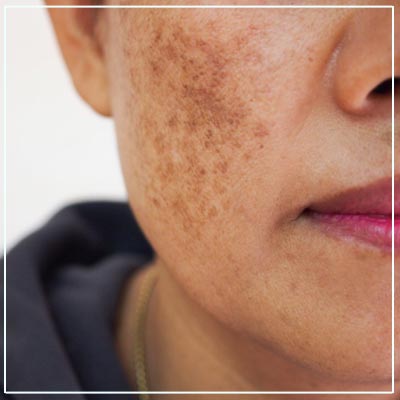Dermatologist-Approved Approaches for Skin Pigmentation Treatment
Dermatologist-Approved Approaches for Skin Pigmentation Treatment
Blog Article
The Ultimate Option for Persistent Skin Coloring Issues Exposed
Skin coloring issues can be a resource of aggravation for numerous individuals, usually verifying to be immune to traditional therapies. The key lies in understanding the root causes of skin discoloration and implementing a detailed strategy that not just addresses existing coloring but additionally prevents its reappearance.
Understanding Skin Coloring Causes
Skin pigmentation is an intricate process influenced by different internal and exterior elements that contribute to the formation of dark places or patches on the skin. The primary source of skin coloring is the overproduction of melanin, the pigment liable for hair, skin, and eye shade. This overflow can be triggered by elements such as sun exposure, hormonal modifications, swelling, and skin injuries.
Sun direct exposure is one of the leading sources of skin pigmentation, as UV rays promote melanocytes to produce even more melanin, bring about tanning or the development of dark spots. Hormone changes, especially throughout maternity or due to hormonal disorders, can additionally lead to skin coloring concerns like melasma or chloasma. Swelling triggered by conditions like acne or eczema can trigger post-inflammatory hyperpigmentation, leaving behind stubborn dark marks on the skin.
Comprehending these causes is crucial in developing efficient therapies for skin coloring problems. By resolving the underlying variables that add to melanin production, targeted skincare regimens, specialist treatments, and way of living adjustments can aid manage and minimize skin pigmentation problems.
Topical Therapies for Hyperpigmentation
Having established the underlying reasons for skin pigmentation, it is critical to discover reliable topical treatments for dealing with hyperpigmentation worries. Topical therapies are a popular choice for taking care of hyperpigmentation as they can target particular locations and are normally very easy to incorporate into skin care regimens. One of one of the most common ingredients in topical treatments for hyperpigmentation is hydroquinone, which works by inhibiting the enzyme in charge of melanin manufacturing. Nonetheless, hydroquinone may not appropriate for all skin types and can create irritability in some people.
Other effective topical treatments for hyperpigmentation include kojic acid, which is originated from fungi and can help lighten dark places by inhibiting melanin manufacturing. Vitamin C is also a preferred choice due to its lightening up properties and ability to level skin tone. Additionally, ingredients such as retinoids and niacinamide can aid improve skin texture and lower the look of pigmentation over time.
When making use of topical treatments for hyperpigmentation, it is vital to use sunscreen day-to-day to stop additional eclipse of the skin and to talk to a skin doctor to determine the most appropriate therapy for private skin issues. (Skin Pigmentation Treatment)
Professional Procedures for Pigmentation Improvement
Specialist skin doctors typically suggest a selection of advanced a fantastic read procedures for remedying skin coloring problems. One common specialist treatment is laser treatment, which targets pigmented locations with high-intensity light to break down melanin and decrease hyperpigmentation. Another reliable procedure is chemical peels, where a chemical solution is put on the skin to scrub the external layer, disclosing new, evenly pigmented skin underneath. Microdermabrasion is a non-invasive treatment that uses a minimally unpleasant tool to delicately sand the skin, enhancing total appearance and reducing coloring irregularities.
For much more extreme instances of coloring, dermatologists may suggest intense pulsed light (IPL) therapy, which targets melanin with broad-spectrum light to fade dark areas gradually. In some circumstances, fractional laser treatment may be advised to target particular areas of pigmentation much more precisely. These expert treatments are commonly done in a skin doctor's office and may require several sessions for optimal results. It is necessary to seek advice from a certified skin doctor to identify one of the most suitable therapy choice based on individual skin type and pigmentation problems.


Way Of Life Modifications to Fight Skin Discoloration
Foods like berries, citrus fruits, leafy greens, and nuts can supply essential nutrients that sustain skin regeneration and combat oxidative anxiety, which can contribute to skin staining. Staying hydrated by consuming an appropriate amount of water daily can additionally promote skin health and assist in preserving an even skin tone.
Sunlight protection is important in stopping additional skin discoloration. By making these way of life adjustments, people can take positive steps in the direction of combating read review skin staining and advertising a healthier skin tone.
Maintenance Tips for Long-Term Coloring Control
Regular exfoliation with mild scrubs or chemical exfoliants can aid slough off dead skin cells, enabling for much better penetration of therapy products. Maintaining a healthy and balanced diet regimen abundant in anti-oxidants, vitamins, and minerals can support skin health and wellness and total pigmentation control (Skin Pigmentation Treatment). By adhering to these maintenance suggestions carefully, individuals can properly take care of stubborn skin pigmentation in the long run.

Conclusion
To conclude, resolving skin coloring needs a multifaceted approach including comprehending the reasons, using topical therapies, going through specialist treatments, making way of living modifications, and maintaining long-term control. By incorporating these approaches, individuals can properly fight stubborn skin discoloration issues and accomplish a much more also and radiant complexion.
Skin pigmentation is an intricate process influenced by different learn the facts here now internal and external factors that add to the formation of dark places or patches on the skin. The key cause of skin coloring is the overproduction of melanin, the pigment responsible for hair, skin, and eye color. An additional effective treatment is chemical peels, where a chemical remedy is used to the skin to scrub the outer layer, revealing brand-new, evenly colored skin underneath (Skin Pigmentation Treatment). Foods like berries, citrus fruits, leafy greens, and nuts can supply important nutrients that sustain skin regrowth and fight oxidative stress, which can add to skin discoloration. Staying hydrated by drinking an adequate quantity of water daily can also promote skin health and wellness and aid in preserving an even skin tone
Report this page